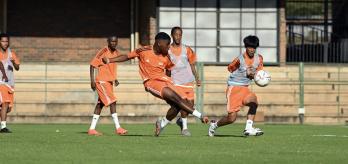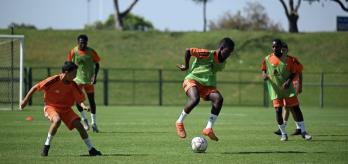Methodology
The intention: What is practised?
The objective of the exercise is to enhance a unit’s ability to transition into attack within a narrow focus. The drill focuses on unit-level aspects, including reacting quickly and adopting an aggressive attacking approach as a collective to transition into attack and take advantage of any gaps left by the opposition. An attack can easily break down if one part of the unit is not ready to transition. The unit must apply a coordinated press, cover-press for one another and remain compact to prevent the opposition from playing through them and to increase their chances of regaining possession. Before winning the ball back, the members of the unit must constantly scan and be aware of the unoccupied spaces to move into and in which team-mates could receive the ball should they win it.
The scale: For whom is this relevant?
The exercise revolves around the unit, with a particular focus on transitioning into attack after possession has been regained. The drill is particularly relevant to midfielders and attackers when their team are out of possession and set up in a high or mid-block. The exercise simulates the in-possession team building up play and trying to play through a press in which the opposition’s front three and three midfielders press in a compact, narrow shape. The attacking transition, which represents the moment when the ball is won high up the pitch or around the halfway line and attacking players come alive and perform a rapid attacking transition, is the key moment in the exercise.
The practice type: How is the practice designed?
The exercise involves a possession game featuring variable repetition that provides ample opportunities for a unit to practise pressing to regain possession, playing forwards and transitioning into attack. The central area and the pressing objective are designed to limit the players’ time and space on the ball, leading to more turnovers of possession, which results in more attacking transitions for players to work on their effectiveness during this phase of the game. The narrow nature of the exercise area encourages the unit to be direct when attacking towards goal, whilst the change of direction adds a level of difficulty for which players must be prepared. The neutral players provide a numerical advantage to make the exercise more challenging for the pressing team, who face a 6v10 scenario. However, the unit are rewarded when they win the ball, as they benefit from the numerical advantage. The activity is non-position-specific.
Session plan
Organisation
-
Use one half of a full-size pitch and position a full-size goal at either end of the exercise area
-
Cone off the exercise area to a width of 18m.
-
Mark out a 18x18m area in the centre of the exercise area with a halfway line running through the middle.
-
Split the group into 2 teams of 6 (blues and oranges) and 1 team of 4 (greens).
-
Ask the blues to remain close to the edges of the central area at all times.
-
Position the oranges up inside the exercise area.
-
Ask the 4 green players to act as neutral players; position 2 inside the central area and 1 at either end of the central area.
Explanation
-
The exercise begins with the blues in possession.
-
The blues aim to retain possession within the central area with the support of the greens.
-
The oranges try to win the ball.
-
If the oranges gain possession, they must transition quickly into attack and, with the support of the greens, try to score in the opposite goal to the half in which they won the ball.
Key coaching points
Roles of coaches
-
First coach: leads the session and explains the exercise.
-
Second coach: observes and occasionally offers encouragement from their position on one side of the exercise area.
- Third coach: encourages players and offers them advice from their position on the opposite side of the exercise area to the second coach.

















